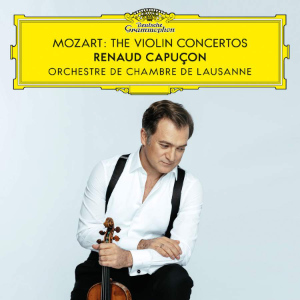
Wolfgang Amadeus Mozart (1756-1791)
Violin Concerto No. 1 in B-flat major, K. 207
Violin Concerto No. 2 in D major, K. 211
Violin Concerto No. 3 in G major, K. 216
Violin Concerto No. 4 in D major, K. 218
Violin Concerto No. 5 in A major Turkish, K. 219
Rondo in C major, K. 373
Adagio in E major, K. 261
Renaud Capuçon (violin)
Orchestre de Chambre de Lausanne
rec. 2022, Théâtre de Beaulieu, Lausanne
Deutsche Grammophon 4864067 [2 CDs: 120]
Hot on the heels of his collaboration with pianist Kit Armstrong in the Mozart Sonatas for Violin and Piano (review), Renaud Capuçon now turns his hand to the composer’s five violin concertos. As Menuhin did in the early 1960s with the Bath Festival Orchestra, Capuçon is both soloist and conductor of the orchestra de Chambre de Lausanne. He’s been its artistic director since 2021.
With the exception of the First Concerto, thought to have been written in 1773 when the composer was just seventeen, the other four were penned two years later when he was nineteen. At the time he was court composer to Archbishop Colloredo of Salzburg, and whether the concertos were intended for his own use or for Antonio Brunetti, the court orchestra leader, well, the jury is still out on that one.
Many aren’t as familiar with the first two concertos as with the final three. No. 2 I find the least interesting of the group. The Violin Concerto No. 1 in B flat major, K207 certainly deserves greater currency as it’s a delightful work. Capuçon’s tempo choices in each of the movements seems just right, and this goes for all the concertos in the set. The Adagio is sensitively sculpted and the finale is imbued with effervescence and youthful exuberance.
The Third Concerto has some refined playing, instinctive phrasing and immaculate finish. Capuçon eschews the ubiquitous Sam Franko cadenza and plays one I’m not familiar with; maybe it’s his own. I’m particularly enamoured by the central Adagio, where the muted strings provide a limpid backdrop to the soloist’s soaring line. The sunny finale is lithe and playful.
The Violin Concerto No.4 in D K.218 has always been my personal favorite of the cycle. It was the very first one I got to know in a version by Joanna Martzy on an old Heliodor LP. I think it’s the most technically demanding of the set, and Capuçon steps up to its challenges admirably. The outer movements are life-affirming and sparkle with energy, especially the first movement’s rhythmically punchy martial theme, whilst the Andante cantabile offers a contrast of beguiling repose.
Capuçon brings elegance, refinement, freshness and spontaneity to the Fifth Concerto. He fully savours the captivating lyricism of the slow movement. The Turkish Rondo finale is spirited and full of swagger and avoids sounding too frenetic as is frequently encountered in performances. I have to say, I wasn’t too taken with the first movement cadenza, which I found rather dull.
Also included are the Rondo in C major K 373 and Adagio in E major K 261. These two attractive fillers are approached with the same degree of urbanity as the concertos.
On the evidence, Capuçon is a fine and convincing Mozartian, performing with refinement, simplicity and directness. He commands a superb technique and there’s a gleaming polish to his playing. His fine-spun tone is ideally suited to these works. The Lausanne ensemble are scaled down admirably and the balance between orchestra and soloist is finely judged. Certainly for those approaching these wonderful works for the first time, this is as good an introduction as any.
Stephen Greenbank
Help us financially by purchasing from




















